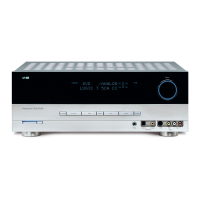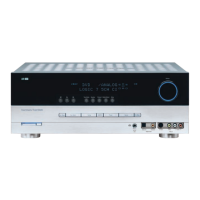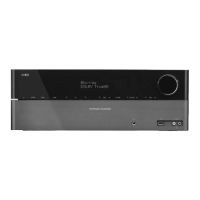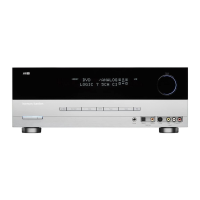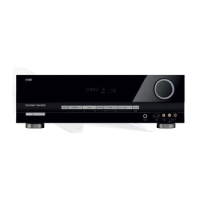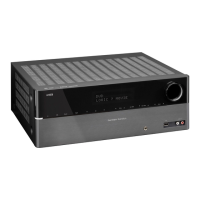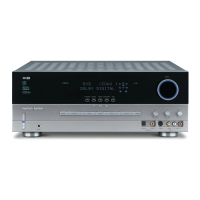SYSTEM CONFIGURATIONSYSTEM CONFIGURATION
20 SYSTEM CONFIGURATION20 SYSTEM CONFIGURATION
encoded programs or standard 2-channel program-
ming of any type, respectively. For 6.1/7.1 configura-
tions, the Music and Cinema modes may be selected.
T
he Logic 7 modes are not available when either
D
olby Digital or DTS digital soundtracks are in use.
See page 28 for an explanation of Logic 7 modes.
On the
DSP(SURR) menu, the choices made
w
ith the
‹
/
›
B
uttons
o o
n the remote select from
one of the DSP surround modes that are designed
for use with 2-channel stereo programs to create a
variety of sound field presentations. The choices avail-
able are Hall 1, Hall 2 and Theater. The Hall and
Theater modes are designed for multichannel installa-
tions, and are available in 5.1- or 6.1-channel ver-
sions. See page 28 for a complete explanation of
the DSP surround modes.
The
VMAx menu offers virtual processing that deliv-
ers a full surround field when only the front left and
right speakers are installed. The
NEAR mode is rec-
ommended for situations where the speakers are less
than 5 feet from the listening position. The
FAR
mode is optimized for installations where the listening
area is more than 5 feet from the speakers.
On the
STEREO menu, the choices made with
the
‹
/
›
Buttons o on the remote may either turn
the surround processing off for a traditional 2-channel
stereo presentation, or select
5 STEREO or
7 STEREO
depending on whether a 5.1 or 6.1/
7.1 configuration is in use. The latter modes feed a
2-channel presentation to all speakers, regardless
of the number of speakers in use. See page 29 for
a com
plete explanation of the Stereo modes.
NOTE ON ANALOG BYPASS MODE: If an analog
audio source is selected and you have full-range front
speakers, you may select an analog bypass 2-channel
mode in which the analog signal is routed directly from
the input to the volume control, without being digitized
or processed.
The
analog bypass
mode is selected as
one of the surround modes.
First, be sure to remove the tone controls from the
circuitry by pressing the
Tone Mode Button 4.If
the
TONE OUT message appears in the Lower
Display Line
Q,
then simply wait a few seconds for
the message to disappear. Otherwise, press the
‹
/
›
Buttons 9o until TONE OUT does appear.
Then, press the
Stereo Mode Select Button R
on the remote,
or press the
Surround Mode Group
Selector
6 on the front panel until the Stereo
modes are selected. Scroll through the Stereo modes
by pressing either the
Stereo Mode Select Button
R or the Surround Mode Selector 7 until
SURROUND OFF appears in the Lower
Display Line
Q and on screen. Depending on the
direction of your scroll,
the
DSP Surround Mode
Indicator
R may or may not be lit. Continue to
scroll for the DSP indicator to appear or disappear
.
When the
DSP Surround Mode Indicator R is lit,
the input signal is being digitized and bass manage-
ment settings will be applied. For example, if you have
s
et the front speakers to
S
MALL
,
this setting will
b
e selected. When the
D
SP Surround Mode
Indicator
R is not lit, analog bypass mode is
engaged. The AVR will automatically configure the
front speakers as
LARGE, overriding your manual
c
onfiguration. See below for more information on
Speaker Setup.
After the selections are made on the Dolby, DTS,
Logic 7, DSP (Surround), VMAx or Stereo menu,
press the
⁄
/
¤
Buttons n so that the cursor
moves to the
BACK TO MASTER MENU
line and press the Set Button p.
Manual Setup
The remaining configuration settings establish the
number of speakers in your system and their charac-
teristics. These settings are designed to tailor the
AVR 140’s performance to the specific characteristics
of your loudspeakers and your listening room.
To begin manual setup using the full-OSD menu
system, press the
OSD Button L so that the
MASTER MENU appears on screen. Press the
⁄
/
¤
Buttons n until the
›
cursor points to the
MANUAL SETUP line, and press the Set
Button
p. The MANUAL SETUP menu
(Figure 7) will appear.
Figure 7
Adjust the submenus in the MANUAL SETUP
submenu in order, as some settings require that previ-
ous settings be established first.
Speaker Size
This menu tells the AVR 140 which type of speakers
are in use
.
This is important as it adjusts the settings
that decide whether your system will use the “5-chan-
nel” or “6-channel/7-channel” modes, as well as
determining which speakers receive low-frequency
(bass) information.
Y
ou will first need to access the
SPEAKER
SIZE
submenu. With the MANUAL SETUP
submenu on screen, the › cursor should be pointing
to the first line
,
SPEAKER
SIZE
.
If it is not,
use the
¤ Button n until it is, then press the Set
Button
p.
The
SPEAKER
SIZE
submenu
will appear (see Figure 8).
Figure 8
For each of these settings, use the LARGE setting
i
f the speakers for a particular position are traditional
full-range loudspeakers
.
Use the
SMALL setting for
smaller, frequency-limited satellite speakers that do not
reproduce sounds below 200Hz. Note that when
“small” speakers are used, a subwoofer is required
to reproduce low-frequency sounds. Remember that
the “large” and “small” descriptions do not refer to the
actual physical size of the speakers, but to their ability
to reproduce low-frequency
sounds. If you are in
doubt as to which category
describes your speakers,
consult the specifications in the speakers’ owner’s
manual, or ask your dealer.
Begin the speaker setup process by making certain that
the cursor is pointing toward the
LEFT/RIGHT
line, which sets the configuration for the front left and
right speakers. If you wish to make a change to the
front speakers’ configuration, press the
‹
/
›
Buttons
o so that either LARGE or SMALL appears,
matching the appropriate description from the definitions
shown above.
When
SMALL is selected, low-frequency sounds will
be sent only to the subwoofer output. If you choose this
option and there is no
subwoofer
connected, you will not
hear any low-frequency sounds from the front channels.
When
LARGE is selected, a full-range output will be
sent to the front left and front right outputs. Depending
on the choice made in the
SUBWOOFER line in
this menu, bass information may also be directed to the
front left/right speakers, a subwoofer or both.
NOTE ON ANALOG BYPASS MODE: If an analog
audio source is selected and you have full-range front
speakers,
you may select an
analog bypass
two-chan
-
nel mode in which the analog signal is routed directly
from the input to the volume control, without being
digitized or processed.
The analog bypass mode is
selected as one of the surround modes. See the
note to the left for detailed instructions.
When the DSP
Surround Mode Indicator ˆ is lit
in
Surround Off mode, the input signal is
being digitized and bass management settings will be
applied. For example, if you have set the front speak-
ers to
SMALL, this setting will be selected. When
the DSP
Surround Mode Indica
tor
ˆ is not lit,
* SPEAKER SIZE *
LEFT/RIGHT:SMALL
CENTER :SMALL
SURROUND :SMALL
SURR BACK :SMALL
SUBWOOFER :SUB
BASS MGR :GLOBAL
BACK TO MANUAL SETUP
* MANUAL SETUP *
SPEAKER SIZE
SPEAKER X-OVER
DELAY ADJUST
CHANNEL ADJUST
BACK TO MASTER MENU
AVR 140 OM 3/29/06 3:45 PM Page 20
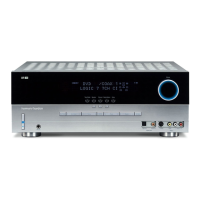
